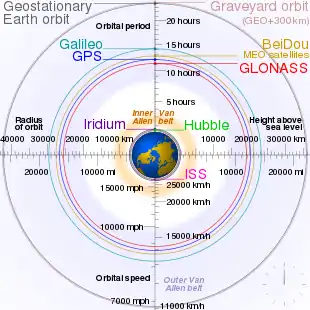Medium Earth orbit
Medium Earth orbit (MEO), sometimes called intermediate circular orbit (ICO), is the region of space around Earth above low Earth orbit (altitude of 2,000 km (1,243 mi) above sea level) and below geosynchronous orbit (altitude of 35,786 km (22,236 mi) above sea level).[1]


The orbit is home to a number of artificial satellites – the most common uses include navigation, communication, and geodetic/space environment science.[1] The most common altitude is approximately 20,200 kilometres (12,552 mi), which yields an orbital period of 12 hours, as used, for example, by the Global Positioning System (GPS).[1] Other satellites in medium Earth orbit include Glonass (with an altitude of 19,100 kilometres (11,900 mi)[2]) and Galileo (with an altitude of 23,222 kilometres (14,429 mi))[3] constellations. Communications satellites in MEO include the O3b and forthcoming O3b mPOWER constellations for telecommunications and data backhaul to maritime, aero and remote locations (with an altitude of 8,063 kilometres (5,010 mi)).[4] Communications satellites that cover the North and South Pole are also put in MEO.[5]
The orbital periods of MEO satellites range from about 2 to nearly 24 hours.[1] Telstar 1, an experimental communications satellite launched in 1962, orbited in MEO.[6]
Satellites in MEO orbits are perturbed by solar radiation pressure which is the dominating non-gravitational perturbing force.[7] Other perturbing forces include: Earth's albedo, navigation antenna thrust, and thermal effects related to heat re-radiation.
See also
Notes
- Orbital periods and speeds are calculated using the relations 4π2R3 = T2GM and V2R = GM, where R, radius of orbit in metres; T, orbital period in seconds; V, orbital speed in m/s; G, gravitational constant, approximately 6.673×10−11 Nm2/kg2; M, mass of Earth, approximately 5.98×1024 kg.
- Approximately 8.6 times (in radius and length) when the moon is nearest (363104 km ÷ 42164 km) to 9.6 times when the moon is farthest (405696 km ÷ 42164 km).
References
- "Definitions of geocentric orbits from the Goddard Space Flight Center". User support guide: platforms. NASA Goddard Space Flight Center. Archived from the original on May 27, 2010. Retrieved 2012-07-08.
- "The Global Navigation System GLONASS: Development and Usage in the 21st Century". 34th Annual Precise Time and Time Interval (PTTI) Meeting. 2002. Retrieved 28 February 2019.
- Galileo Satellites
- O3b satellites
- Satellite Basics: Solution Benefits Archived 2013-11-19 at Archive.today
- "Medium Earth Orbit". Archived from the original on 2017-06-09. Retrieved 2007-01-04.
- Bury, Grzegorz; Sośnica, Krzysztof; Zajdel, Radosław; Strugarek, Dariusz (February 2020). "Toward the 1-cm Galileo orbits: challenges in modeling of perturbing forces". Journal of Geodesy. 94 (2): 16. doi:10.1007/s00190-020-01342-2.